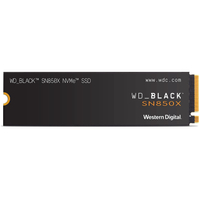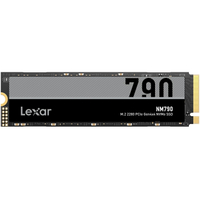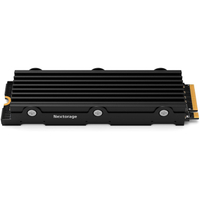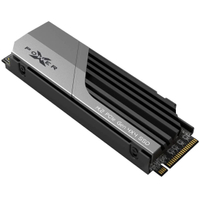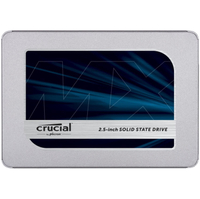Best SSD for gaming in 2024
Give your gaming PC a serious speed boost with the best SSD for gaming.
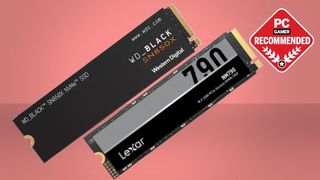
⚙️ The list in brief
1. Best overall
2. Best budget
3. Best 2TB+
4. Best for Steam Deck
5. Best for PS5
6. Best SATA SSD
7. Best PCIe 5 SSD
8. How we test
9. Where to buy
19. FAQ
When it comes to your games and most PC tasks, a fast solid state drive makes an absolute world of difference. Compared to a conventional HDD, buying one of the best SSDs for gaming means your load times will become trivial, you'll be much less prone to stutter, and your PC gaming experience becomes much more smooth, serene and lightning fast. A good SSD gets you straight to the action, and that's right where any PC gamer wants to be.
The best SSD for gaming on the market is currently the WD Black SN850X. It's got a great blend of performance and affordability that's perfect for PC gaming. However, when it comes to affordability we're also big fans of the supremely good-value and lightning fast Lexar NM790 , which is our current top recommendation for the best budget gaming SSD.
We conduct extensive testing to pick out the top SSDs. A 512GB drive may seem tempting for the money, but might not be worth it given the size of gaming installs, so 1TB to 2TB is likely where you'll want to aim. We currently recommend Gen 4 drives over Gen 5, as there's little real world advantage over the latest versions, but if that changes we'll of course update this guide to reflect that.

Jeremy likes CPUs. And GPUs. And SSDs. A lot. Which is just as well, since he's been writing about them since the early Mesozoic period. Or at least since Intel released those early stuttering SSDs. Remember them? Good times.
The quick list

Best overall
The WD Black SN850X is a fantastic all-rounder when it comes to gaming SSDs, and even though it's been around for a while it's still the best overall NVMe drive out there right now.
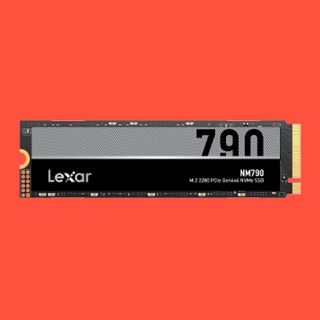
Best budget
The Lexar NM790 is a great performing Gen 4 SSD from a respected manufacturer that costs a lot less than you might expect, while making very few real-world compromises.
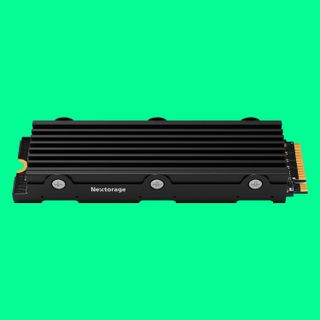
Best high capacity
If you're looking for large amounts of speedy storage without spending too much, then the Nextorage NEM-PA NVMe makes for an excellent pick as a great performing high-capacity drive for sensible prices.
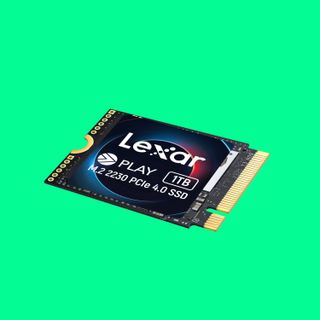
Best for Steam Deck
Need more storage in your Steam Deck? Well, this 1TB 2230 from Lexar is the one to get. Fast, cool, and great value for money. Shame there isn't a bigger version at the moment.
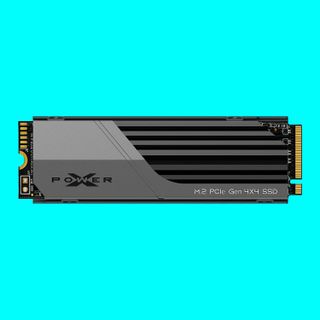
Best for PS5
The latest Phison controller in combination with some high-performance NAND flash memory makes the Silicon Power XS70 an extremely fast drive for Sony's PlayStation 5.
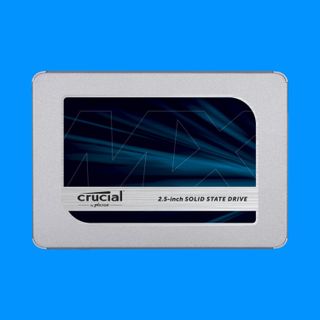
The best SATA
If you can't fit an NVMe SSD inside your PC, or you've too many already, then a SATA drive is still a solid option for speedy, non-essential storage. This Crucial is still a lot quicker than any hard drive, that's for certain.

Best PCIe 5 SSD
If you really must have the fastest SSD possible in your gaming PC, then don't spend any more than you need to. The T-Force Z540 is the best Gen 5 SSD because it's super fast but not super expensive.
Recent updates
This article was updated April 26 2024 to include a new PCIe 5.0 (Gen 5) category, as well as check and update our other recommendations.
The best gaming SSD



Specifications
Reasons to buy
Reasons to avoid
Our favorite WD Black SN850X config:
WD_Black SN850X | 2TB | 7,300 MB/s read | 6,600 MB/s write
This drive comes in a variety of capacities, but we particularly like the 2TB flavour here. Still, no matter which one you go for, this is a fantastic all-round gaming SSD, and tops our recommendations for very good reason.
✅ If you want a great all-rounder: The SN850X has a winning combination of great speeds, cool running and affordability that's difficult to beat.
✅ If you don't want to worry about temps: Whether you go for the heatsink model or not, the WD Black SN850X stays chilled out.
❌ You want the absolute cutting edge of performance: There are slightly faster drives, or much faster if you go for Gen 5, but realistically this is all the real-world speed you're going to need for the time being.
The best SSD for gaming is currently the WD Black SN850X, and while it might have been on this list for a while, it's still the one we'd pick for the best combination of all the things you might want from a gaming solid state drive.
PCIe Gen 5 is now a thing on both AMD and Intel platforms. But let’s be real. Your current PC almost certainly doesn’t have a PCIe 5.0 M.2 slot, and even if it does, Gen 5 drives run hot and cost a pretty penny. The WD Black SN850X might be something of a last hurrah for Gen 4 SSDs, but it's still the best one out there for an overall balance of cost, speed and efficiency.
The 1TB model we reviewed is now the entry-level option, which makes sense given the size of modern game installs. WD’s in-house controller chip, provided by compatriot SanDisk, has been revised, and we found that this, in addition to some higher-density NAND, means that the WD Black SN850X truly flies.
This WD drive makes use of the latest 2.0 version of the company's Game Mode drive management software. WD claims it improves game loading times courtesy of a so-called "read look-ahead" algorithm, which predictively caches game data. It now runs automatically, detecting when games are loaded. How much that kind of feature actually makes a difference in the real world is difficult to pin down.
What we do know is that, as a gaming drive, it puts on an excellent showing. With read speeds of 7,300 MB/s and 6,300 MB/s writes, it's a real performer, and not only that it stays cool, calm and collected while it does it.
We tested a version with WD's armour-style cooler, but in all honesty, it doesn't need one. It runs cool regardless of the heatsink, and even cooler in fact than the WD Black SN850 that came before it.
The old SN850 hit a rather toasty 77°C, whereas this new drive hits just 58°C under sustained load, which is quite an improvement. The 4K random access results were maybe a little bit disappointing, showing little to no improvement over the previous drive, and you shouldn't expect huge gains in PC Mark 10 either.
That being said, this is a fantastic all-round drive and improves on its predecessor enough that we think it deserves to sit at the tippy-top of this list for the best gaming SSD. Fast gaming speeds, cool running, great pricing, and a software suite that finishes off a very attractive package, whether you go for that aggressive heatsink or not.
It's an all-rounder, a jack-of-all-trades, and a mighty addition to any gaming PC worth its salt.
Read our full WD Black SN850X SSD review.
The best budget gaming SSD



Specifications
Reasons to buy
Reasons to avoid
Our favorite Lexar NM790 config:
Lexar NM790 | 1TB | 7,400 MB/s read | 6,500 MB/s write
If you're looking for super-fast speeds without a super-high price, the Lexar NM790 has several tricks up its sleeves to make all that not just possible, but advisable too. It's fast, cool and reliable, and makes for a fantastic gaming drive.
✅ If you want top end performance for less: The Lexar NM790 is damn near as fast as the top Gen 4 performers, but regularly comes in significantly cheaper
✅ If you don't want a heatsink: We tested the heatsink-less model, and found its thermal performance was great, making it a very good laptop or small form factor solution.
❌ You'd prefer some more known components: The controller and flash combination here is a bit of an anomaly, but we've had no problem with the drives we tested and are still using long term. Still, if cheaper components bother you, you might want to look elsewhere.
NVMe drives, especially some of the faster ones, used to be a bit of an expensive proposition, but thanks to some clever usage of components you might not be as familiar with it's now possible to buy a really, really fast drive for less than you might expect. Enter, the Lexar NM790, an SSD that delivers as much meaningful performance as you could want while still remaining affordable. That makes it the best budget gaming SSD we've tested, and if you read on, I'll tell you exactly why.
While other gaming SSDs make use of known entities like the Phison E18 for a controller chip, the Lexar instead uses a lesser-known model, the MaxioTech MAP1602A, alongside some YMTC 232-layer TLC memory. If those sorts of unfamiliar names make you nervous, there's no need to worry. These components might make the drive cheaper overall, but when it comes to performance, they've really got the gaming goods.
Sequential read and write times? 7,400 MB/s and 6,500 MB/s respectively, putting the Lexar NM790 up there with some of the very fastest Gen 4 drives we've tested. With a 3,000 TBW rated endurance there's very little to worry about reliability-wise either, especially as the Lexar likes to run relatively cool.
We tested the heatsink-less 4TB model and found that under moderate load, copying a 30GB test folder, the Lexar managed a peak temperature of 57°C. That's surprisingly chilled out for such a fast drive with no heatsink, although if you're the sort of person that likes to wear braces with your belt just in case, a heatsink-equipped version is available for a little bit more, although in all honesty, it's not necessary to make sure the NM790 delivers its maximum performance.
Pushing even further, we put the drive under a much more intense test, transferring 200GB of data in one steady stream. This is something the average user is very unlikely to do very often, but still, the heatsink-free drive managed a respectable 72°C peak.
In real-world usage, the NM790 makes use of some clever SLC caching to reach its top speeds with a large cache buffer, and we found this solution delivered excellent performance. While it is possible to push this system to its limits and find the cracks, if you're going to be gaming on this drive—and let's face it, that's probably why you're here—be rest assured that its gaming performance is superb.
Yep, the Lexar impressed us greatly with everything you could reasonably want in a gaming SSD with no major caveats. Some will still be put off by the lesser known components, but those that are prepared to take the leap (and let's face it, with a known respected brand like Lexar, it's not all that much of one) will find a very high-performance drive that runs cool and delivers all the real world performance you could want while keeping its costs low as can be.
You can even find them on discount fairly often if you're prepared to keep an eye on our cheap gaming SSD page, which of course we highly recommend. Still, even at full price this drive is a stormer for less, and easily our top pick for the best budget gaming SSD. Simple as that, folks. Simple as that.
Read our full Lexar NM790 4TB review.
The best high capacity SSD





Specifications
Reasons to buy
Reasons to avoid
Nextorage Japan | 2TB | 7,300 MB/s read | 6,900 MB/s write
It might not have the brand recognition of its rivals, but the Nextorage NVMe SSD has a truly remarkable amount of performance and capacity, and can be found for very good prices too. This version comes with a substantial heatsink, but versions without are available for small form factor and laptop applications.
✅ You're looking for oodles of space: The Nextorage NEM-PA comes in a variety of sizes, but we particularly like the 2TB and 4TB versions for the money. Speaking of which...
✅ You don't want big prices for big sizes: We see the Nextorage drives on discount all the time, however, even at regular retail prices they represent huge value for money.
❌ You want high speeds from every possible angle: The Nextorage NEM-PA drives have absolutely fantastic real-world performance, but benchmark hounds will notice the 4K numbers and PC Mark synthetic results are a little behind the pack.
Who? What? Never heard of 'em. That might not be the hugest surprise, as Nextorage is relatively new to the game of SSD manufacturing, but you may well be interested to know that this company was originally created by Sony to manufacture drives for the PlayStation 5. A lot has happened since, but Nextorage has now turned its hand to creating large-capacity NVMe drives for PC usage, and damned good they are too. So good in fact, we recommend the Nextorage NEM-PA as our absolute top pick for the best high-capacity gaming SSD.
Let's kick off with a name: Phison. This manufacturer makes the somewhat legendary Phison E18 controller, used in some of the very fastest SSD drives we've had the pleasure of testing. It bought a controlling stake in Nextorage and imbued its drives with said legendary controller, and as a result, the NEM-PA model here is quick as a very, very quick thing.
With sequential reads of 7,300 MB/s and 6,900 MB/s writes for the 2TB model we tested, this drive is absolutely no slouch, and that capacity means you'll have plenty of room for all your game installs. If you're looking to go even bigger still there's a 4TB model that's nearly as quick, and not only that but they're usually available for very reasonable prices.
That means you can realistically pick up a gigantic, very fast SSD for your gaming PC for a price that a few years ago would have seemed ridiculous, with very few caveats.
It gets better too. Nextorage reckons that a full one-third of the memory can be used as high-speed SLC cache, and in our testing we found it managed its top-level performance for around 625GB of sustained writes before dropping off, which is mightily impressive.
Not only that, but it runs cool too. You can find versions without the heatsink that should still run as chilled out as you like, but our chunky heatsink-equipped version hit a peak temperature of 39 degrees. That's about as cool as you could expect a high-speed SSD to go under heavy load, although again the heatsink-free version should still keep itself well in line thanks to some efficient components.
We only found one slight anomaly, and that was a little bit of a disappointing PC Mark 10 storage result, although synthetic benchmarks are designed to find the weak spot in any component. Real-world performance-wise, especially for gaming, the Nextorage absolutely flies, and given the huge amount of capacity, speed and relatively cheap pricing, this is about the best way you can add a ton of fast storage to a modern PC.
It's big, fast, runs cool and keeps on trucking. The best high-capacity gaming SSD has some serious contenders, but these Nextorage drives are the ones that have impressed us the most.
Read our full Nextorage NEM-PA 2TB review.
The best SSD for Steam Deck



Specifications
Reasons to buy
Reasons to avoid
✅ You're looking for a Steam Deck upgrade: With more capacity and way better performance, the Lexar Play 2230 is the perfect addition to any Deck.
✅ You want value for money: 2230-size SSDs tend to be quite a bit more expensive than 2280 ones, but this one is only a little extra. It's very reasonably priced.
❌ You want more than 1TB: Until Lexar offers a bigger model, you're out of luck. Fortunately, 1TB is still a decent amount of storage.
Lexar is relatively new to the SSD scene but it has rapidly made a name for itself, by offering fast storage, with bags of capacity, and all with sensible prices. Its Play 2230 model is no exception and it's by far the best SSD for the Steam Deck.
Underneath the label is 1TB of Micron TLC NAND flash memory and a Silicon Motion SM2269XT controller. That's surprisingly decent stuff for a drive that's marketed at the handheld PC category and they help the SSD's performance in no small way. In our testing, we found that the claimed peak read/write figures of 5,400 and 4,700 MB/s were very accurate, so you're getting exactly what it says in the specs.
Better yet, the Lexar Play has a large SLC cache—this is the portion of the flash memory that acts as a buffer for data, helping it maintain performance when writing lots of information. In a sustained write test, we measured the cache to be around 240GB, which is pretty big for this type of SSD.
And the good news keeps on coming, as the Lexar Play doesn't get hot, even when pushed hard. With average operating temperatures around the 40°C mark and peaks of 53°C, your Steam Deck won't get any toastier just because you've installed a fast SSD.
There's only one downside to the Lexar Play: the capacity range on offer. 1TB is currently the largest model on offer, and there's plenty of competition with larger capacities, such as our previous recommendation for Steam Decks, the Sabrent Rocket 2230.
Still, 1TB is a decent enough amount of storage, and when it's this fast, cool, and affordable, you really can't complain.
Read our full Lexar Play 2230 1TB SSD review.
The best SSD for PS5

Specifications
Reasons to buy
Reasons to avoid
Our favorite Silicon Power XS70 SSD config:
Silicon Power 2TB XS70 | 2TB | 7,100MB/s read | 6,600MB/s write
The 2TB model can be found at a very competitive price and works extremely well as an expansion drive for the PlayStation 5. With super fast read/write speeds and an attractive and great-performing heatsink, this little drive is deceptive in all the right ways.
✅ You're looking for the best drive for your PS5 : Several SSDs have been built to fit in a PlayStation 5, but this one stands out with its excellent thermals and speeds despite its small heatsink.
✅ If you want a set and forget solution: The Silicon Power XS70 is a no-fuss solution to a potentially fussy problem. It's an all-round great drive for the PS5 that fits in perfectly with no major caveats.
❌ You want included software for a PC install: The XS70 makes for an excellent PC SSD as well, but if you're looking for cloning software or indeed, any SSD software at all, you'll want to find a third-party solution.
Console gaming? On the PC Gamer website? Why absolutely. We're not total PC snobs here, we'll have you know, and even we enjoy the odd session on a PlayStation 5. Trouble is, the Gen 4 drive included as standard, while delivering good performance, isn't the fastest or the largest. So why not give it an SSD spruce up, and we can think of none better than the Silicon Power XS70 as our top pick for the best gaming SSD for the PS5.
Silicon Power is a brand that probably doesn’t get much attention compared to the likes of Samsung or WD, but when you look at its XS70 NVMe SSD with its high-end specifications, it's clear that the brand name isn't everything. Armed with the latest Phison controller and high-performance NAND flash memory, a drive like the Silicon Power XS70 has no problem competing with the best SSDs on the market.
The Silicon Power XS70 2TB SSD is a 2280 (80mm length) M.2 PCIe NVMe drive. It combines Micron 176-Layer TLC NAND with a Phison PS5018-E18 controller and 2GB of DDR4 RAM. That combination is common to many of the best SSDs, including the highly regarded Seagate FireCuda 530 and Kingston KC3000. That puts it in some fierce company, but we're happy to report this little drive more than holds its own, with blazing fast read/write speeds of 7,300 MB/s and 6,800 MB/s respectively.
The XS70 is designed with PS5 compatibility in mind so the heatsink isn’t as bulky as some others you might come across. In fact it looks more like a flash drive, but don't let that put you off. When it comes to loading up your favourite PS5 drives in double quick time, this little wonder has you covered.
It's a highly competitive gaming SSD with great performance, an attractive design and it offers good value for money. It's not perfect, in that it lacks its own software and hardware encryption, but whether you're a PS5 or PC gamer, that won't matter. Load it up with your game library, whether that's console or otherwise, and we reckon you'll absolutely love it.
It's fast, large in capacity, small in physical size, and will slot right into a PlayStation 5 with absolute ease. Just about all you could want in a PS5 upgrade, and a gaming SSD that makes those happy controller-tapping hours all the more pleasant an experience.
Read our full Silicon Power 2TB XS70 review.
The best SATA SSD
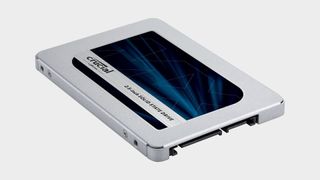
7. Crucial MX500
Our expert review:
Specifications
Reasons to buy
Reasons to avoid
Our favorite Crucial MX500 config:
Crucial MX500 | 1TB | 560 MB/s read | 510 MB/s write
It's not always possible to jam an NVMe SSD into your PC or laptop, and if that's the case then you need a great SATA drive. And the Crucial MX500 is most definitely that. With a full terabyte of storage and performance at the limit of the SATA interface, it's a quality drive.
The Crucial MX500 is the only SATA drive left on our list of the best SSDs for gaming, but it's still the best SATA SSD we can think of. When the price delta between PCIe and SATA is so small, if occasionally non-existent, it's difficult to make an argument for the far slower technology. But, as there is a hard limit on the number of M.2 slots on your motherboard, there is still a place for SATA SSDs as secondary storage.
And the Crucial MX500 is one of the best. With SATA's maximum theoretical bandwidth limit of 600MB/s, it's nearly as quick as you'll get, and Crucial's drives have long been among the best-value options available too. This is the most affordable 1TB SATA drive you can pick up and it makes a great second home for your Steam and Epic libraries.
It will happily function as a boot drive on systems with no M.2 sockets, or at least no bootable M.2 sockets anyway. You will still be missing out on the zippy response of your operating system running on the SSD-specific NVMe protocol, but if that's not an option anyway, this drive will see you right.
SATA SSDs might be gradually going the way of the dinosaur, but this drive still delivers good storage performance, in a form factor that still might have some go in it just yet.
The best PCIe 5 SSD




Specifications
Reasons to buy
Reasons to avoid
✅ You want ludicrous speed from your storage: Going down the RAID route is expensive and complicated, but a single PCIe 5 SSD will be just as good.
❌ You're expecting great things from Gen 5: You'll barely notice the difference between this and a decent Gen 4 SSD in games and general use.
❌ You don't like heat: All Gen 5 drives get hot so you'll need to ensure you have a proper SSD cooler or a motherboard with good M.2 heatsinks.
It might seem odd to say this but we don't really recommend PCIe 5.0 (also known as Gen 5) SSDs at the moment. They're too expensive and too hot, and the performance capability is wasted in today's gaming PCs. But if you really must have one, then the best PCIe 5 SSD to get is this Teamgroup T-Force Z540.
The performance is rated for up to 12,400 MB/s and 11,800 MB/s for sequential read/writes for the 2TB and 4TB versions, whereas the 1TB model is a little slower, with figures of 11,700 MB/s and 9,500 MB/s respectively. Those data speeds are roughly 70 to 90% higher than the best Gen 4 drives you'll find, so you'd expect the Z540 to turn your gaming PC into an absolute beast.
Except it won't in games because no game is held back by a Gen 4 drive, even if it's an average one. It'll be a good while yet before anything shows notably faster loading or higher fps, just because you have a PCIe 5.0 SSD. And don't expect Windows to be significantly better, either.
Gen 5 SSDs only make sense for those users who need to read and write lots of data very rapidly (e.g. 8K video editing), and would normally use a RAID setup to get the required performance. Swapping a pair of drives for a single SSD has the potential to be more cost-effective, though the average price of most Gen 5 drives counters that whole idea.
But that's the best part of Teamgroup's Z540—the 1TB drive is quite sensibly priced, though as you go up in capacity, the price tag rapidly increases. It's still a lot more expensive than a good Gen 4 SSD but that's par course for all PCIe 5.0 drives at the moment.
If that doesn't put you off and you have the right level of cooling required to stop the SSD from thermal throttling (either a dedicated heatsink and fan, or a motherboard with good M.2 heatsinks), then the T-Force Z540 is the sensible choice for a PCIe 5 SSD.
Read our full Teamgroup T-Force Z540 2TB SSD review.
How we test SSDs
We put every SSD we get in the PC Gamer labs through their paces in various benchmarks made up of a mix of synthetic tests and real-world applications. To ascertain a drives sequential throughput, we use ATTO SSD Benchmark for compressible data (a best-case scenario) and AS SSD for incompressible data (more realistic). We also test random throughput with AS SSD and a combination of CrystalDiskMark 7.0 and Anvil Pro.
When it comes to the real-world tests, we time how long it takes to copy a 30GB game install across the drive and use PCMark10 and Final Fantasy XIV: Shadowbringers, which includes a level load test.
We also check operating temperatures to ensure that the drive isn't getting too hot and throttling. That's becoming more of an issue with faster and faster drives. PCIe 5.0 drives appear to require a lot more cooling than previous generations, which does make you wonder if the extra speed is really worth it yet.
Where to buy the best SSDs
Where are the best gaming SSD deals?
In the US:
- Amazon - Up to 50% off internal and external SSDs
- Walmart - Deals on internal and external SSDs
- B&H Photo - Save up to $50 on NVMe SSDs
- Best Buy - Great prices on Samsung SSDs
- Staples - Save up to 30% on a range of SSDs, USB sticks, and external SSDs
- Newegg - Plenty of NVMe SSDs
In the UK:
- Amazon UK - Save on HDDs, SDDs, and external drives
- Scan - SATA drives as low as £21
- Box - Save up to £82 on Western Digital SN750 NVMe SSDs
- Ebuyer - 500GB SSDs starting from £34.98
- Overclockers - Save up to £51 on Samsung SSDs
- Currys - Save £32.00 on WD Black SN750
- Laptops Direct - Save on SSDs for your laptop
SSD FAQ
What's the difference between SATA and NVMe PCIe-based SSDs?
As the prices of NVMe SSDs fall every day, we don't see much difference in cost between the best NVMe SSDs and their SATA-based equivalents. When the cheapest 2.5-inch 1TB SATA SSD is only $24 less than an equivalent capacity NVMe PCIe drive (and four times slower), why bother with older SATA technology when you can move into the future for so cheap?
Where SATA's theoretical performance limit is 600 MB/s, and PCIe 3.0's is 4,000MB/s, PCIe 4.0 SSDs can double that figure to a maximum of 8,000MB/s. The current top speed of available Gen4 drives is around 7,000MB/s, which is double that of the previous generation.
PCIe 5.0 SSDs can exceed 10,000 MB/s and onwards up to their theoretical limit around 16,000 MB/s. But for now, they run hot and expensive, so we're not really recommending them just yet.
Can I fit an NVMe SSD on my motherboard?
The M.2 socket has been included on motherboards of all kinds for many years now, so the chances are that there's a spare slot sitting inside your existing gaming PC. Check out your motherboard's specs page online before pulling the trigger on an NVMe SSD purchase, though, to be sure. Those harboring a board that's a few years old now, do yourself a favor and make sure it supports booting from an NVMe drive first. Not all older motherboards do, especially if you're going back multiple CPU generations (maybe a full upgrade is due, if so).
If you don't have any NVMe slots, you can buy expansion add-in cards that will offer one or more NVMe slots in exchange for one of your PCIe slots on your motherboard, just be aware that these are at an added cost and take up precious room.
Can you put a PCIe 4.0 SSD in a 3.0 slot?
Yes, you can. They M.2 socket is identical between the two generations of interface and so a PCIe 4.0 SSD will fit comfortably inside a PCIe 3.0 slot. They will also function perfectly well too, except the Gen4 drive will be limited by the speed of the older interface.
The same goes for PCIe 4.0 and PCIe 5.0 drives. You're just wasting the potential of the higher-speed drive by dropping it into a slower slot, is all, but it will work.
What PCIe generation should I look for?
Right now, PCIe 4.0 is the go-to PCIe generation. That's because it offers a high speed at a reasonable cost. The newest gaming SSDs on the market offer PCIe 5.0 capability, which doubles the theoretical bandwidth an SSD can run at. However, these are few and far between and awfully expensive. Also, the first drives of any PCIe generation tend to end up much slower than what that generation is truly capable of.
Here are the rough speeds for each PCIe generation over x4 lanes:
PCIe 1.0: 1 GB/s
PCIe 2.0: 2 GB/s
PCIe 3.0: 4 GB/s
PCIe 4.0: 8 GB/s
PCIe 5.0: 16 GB/s
How big a gaming SSD should I buy?
The easy answer is: as big as you can afford. With SSDs, the higher capacity, often the quicker they are. That's because you end up with more memory dies plumbed into a multi-channel memory controller, and that extra parallelism leads to higher performance.
We would traditionally say that an entry-level SSD should come in at least 512GB in order to pack in your operating system, for slick general system speed, and your most regularly played games. But such is the increasing size of modern games that a 1TB SSD is increasingly looking like the minimum recommendation, and a 2TB drive or above will really give you some proper breathing room for lots of big game installs.
Comic deals, prizes and latest news
Sign up to get the best content of the week, and great gaming deals, as picked by the editors.

Jeremy has been writing about technology and PCs since the 90nm Netburst era (Google it!) and enjoys nothing more than a serious dissertation on the finer points of monitor input lag and overshoot followed by a forensic examination of advanced lithography. Or maybe he just likes machines that go “ping!” He also has a thing for tennis and cars.
- Alan Dexter
- Andy EdserHardware Writer
- Chris SzewczykHardware Writer
- Katie WickensHardware Writer
- Jacob RidleySenior Hardware Editor
Most Popular



